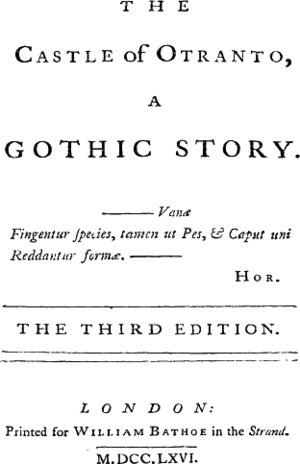Gothic fiction facts for kids
Gothic fiction is a special kind of story that mixes exciting parts of both horror (scary stuff!) and romance (love stories or adventurous tales). Imagine old castles, mysterious secrets, and sometimes a bit of a love story – that's Gothic fiction!
This type of storytelling is thought to have begun in England in 1764. That's when Horace Walpole wrote his famous book, The Castle of Otranto. He even called its second edition "A Gothic Story." Soon, this exciting new style of writing became popular in many other countries too.
Some very famous Gothic stories include Frankenstein by Mary Shelley, written in the early 1800s. Later, the spooky tales of Edgar Allan Poe and Bram Stoker's Dracula also became classics of this genre.
Contents
What is Gothic Fiction?
Gothic fiction is a type of literature that often creates a feeling of mystery and fear. It usually takes place in dark, old settings. Think of crumbling castles, hidden passages, or lonely, spooky houses. These stories often have a sense of doom or suspense.
Key Elements of Gothic Stories
Gothic tales use several common ideas to make them exciting and scary.
Spooky Settings
The setting is super important in Gothic fiction. Stories often happen in old, decaying places. These can be castles, monasteries, or grand, isolated mansions. The buildings themselves often feel like characters. They might have secret rooms, dark dungeons, or hidden staircases. This creates a creepy and mysterious mood.
Mysterious Characters
You'll often find strange or troubled characters in Gothic stories. There might be a powerful, often evil, villain. There could also be a helpless hero or heroine. These characters often have dark secrets or are haunted by their past. They might be dealing with strong emotions like fear, sadness, or obsession.
Supernatural Events
Many Gothic stories include things that can't be easily explained. This might be ghosts, strange noises, or visions. Sometimes, these events are truly supernatural. Other times, they turn out to have a logical explanation. But they always add to the mystery and suspense.
Strong Emotions
Gothic fiction is full of intense feelings. Characters often feel extreme fear, sadness, or despair. The stories explore the darker side of human nature. They can make readers feel a chill down their spine or a sense of dread.
Famous Gothic Authors and Books
Over the years, many writers have created amazing Gothic stories.
Early Gothic Writers
As mentioned, Horace Walpole's The Castle of Otranto started it all. It had a haunted castle, a mysterious curse, and strange events. Another important early writer was Ann Radcliffe. Her book The Mysteries of Udolpho was very popular. It featured a brave heroine trapped in a spooky castle.
Nineteenth-Century Gothic
The 1800s were a golden age for Gothic fiction.
- Mary Shelley's Frankenstein (1818) tells the story of a scientist who creates a monster. It explores themes of life, death, and what it means to be human.
- Edgar Allan Poe wrote many short stories and poems. His works, like "The Fall of the House of Usher", are known for their dark mood and psychological suspense.
- Charlotte Brontë's Jane Eyre (1847) is a classic. It features a mysterious house and a dark secret.
- Bram Stoker's Dracula (1897) introduced the famous vampire. This book set the standard for many vampire stories that followed.
- Robert Louis Stevenson's Strange Case of Dr Jekyll and Mr Hyde (1886) explores the good and evil sides of one person.
Gothic Influence Today
Gothic themes still appear in books, movies, and TV shows today. Many modern horror and suspense stories owe a lot to the original Gothic style. The idea of a creepy old house or a hidden family secret is still used to create thrilling tales.
Images for kids
-
The ruins of Wolf's Crag castle in Walter Scott's The Bride of Lammermoor (1819)
-
Strawberry Hill, an English villa in the "Gothic Revival" style, built by Gothic writer Horace Walpole
-
Ann Radcliffe's The Mysteries of Udolpho (1794), a bestselling Gothic novel. Frontispiece to 4th edition shown.
-
Catherine Morland, the naive protagonist of Northanger Abbey (1818), Jane Austen's Gothic parody
-
Jane Eyre's trial through the moors in Charlotte Brontë's Jane Eyre (1847)
-
Robert Louis Stevenson's Strange Case of Dr Jekyll and Mr Hyde (1886) was a classic Gothic work of the 1880s, seeing many stage adaptations.
-
Le Horla (1887) by Guy de Maupassant
-
Mrs. Danvers in the 1940 film adaptation of Daphne du Maurier's Rebecca.












